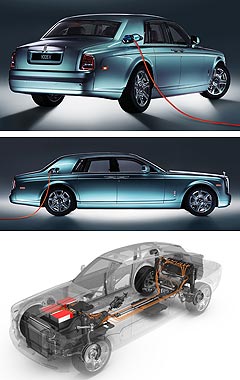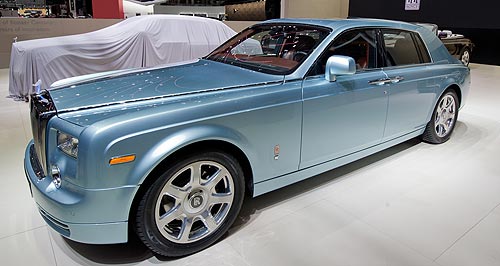Make / Model Search
Future models - Rolls-Royce - PhantomGeneva show: Rolls-Royce 102EX EVPlug-in: Electric 102EX Rolls-Royce boosts the venerable marques' environmental credentials. EV Rolls-Royce 102EX has naturally-tanned leather interior2 Mar 2011 SUSTAINABILITY is the theme of Rolls-Royce’s Phantom-based, all-electric 102EX experimental vehicle at this years’ Geneva motor show. Not only does the one-off prototype offer an expected zero tailpipe emissions range of up to 200km, a 0-100km/h time of under eight seconds and a governed top speed of 160km/h, it also debuts a new take on eco-friendly interior materials. The BMW-owned, British luxury brand’s EV follows a similar front battery, rear motor layout as adopted by the Tesla Model S and Australian EV Engineering’s proposed electric Commodore. Under the long bonnet of the 102EX lives a huge 71kWh lithium-ion battery pack, made up of 96 cells packed into five modules and laid out in a similar shape to that of the original engine and gearbox. Attached to the rear subframe are twin 145kW electric motors driving the rear wheels through a single-speed transmission. The combined output of 290kW falls short of the petrol V12’s 338kW but the torque output of 800Nm is 80Nm up on the combustion engine - sufficient to cope with the extra 235kg it has to haul over the original’s already hefty 2485kg. The battery pack, thought to be the world’s largest passenger car battery, has four charging units, enabling three-phase fast charging in eight hours, single-phase charging from a standard household socket in 20 hours and even wireless charging using inductive technology.  Wireless charging requires the 102EX to be parked over a floor-mounted transfer pad, which uses electromagnetic energy to ‘send’ power to a corresponding induction pad on the underside of the car. Wireless charging requires the 102EX to be parked over a floor-mounted transfer pad, which uses electromagnetic energy to ‘send’ power to a corresponding induction pad on the underside of the car.Rolls-Royce says the system is 90 per cent efficient, the car does not have to be perfectly aligned with the transfer pad for it to work and that it is designed to shield bystanders from the electromagnetic energy. Identifying the 102EX against a standard Phantom is a transparent and LED-illuminated Spirit of Ecstacy crowning the trademark grille. Red Rolls-Royce emblems are the traditional signifier for an experimental car and a special ‘Atlantic Chrome’ paint finish employing ceramic nano particles 1000 times smaller than normal metallic paint particles provides a liquid look for visual impact. Other than these touches, a charging point with transparent cover is the only other externally obvious difference. Rolls-Royce chief designer Ian Cameron said, “It’s a credible design concept that perfectly complements the experimental nature of the car, exploring options in light, space and use of materials. Had we changed the overall aesthetic, the concept would have lost credibility our audience would assume it was simply a styling exercise. The reality is that this is an experimental vehicle in its truest sense, challenging perceptions, emotions and values - as well as exploring alternative drive-train technology.” Inside, the level of luxury remains as expected, with the dashboard dials in the same Atlantic Chrome finish as the bodywork and some instruments such as the fuel gauge modified for EV use. The Phantom’s power reserve gauge has also been repurposed to also show the amount of energy recuperation taking place during deceleration. The greatest interior change is the switch to ‘Corinova’ leather, which uses a chrome-free, natural tanning process. Chestnut extract and crushed South American Tara fruit are used in a drum-spun colouring process, resulting in earthy brown colours and the hide’s grain remaining highly visible. The tanning process is said to produce less waste and Rolls-Royce also believes that with further development the leather will be recyclable for agricultural purposes. Rolls-Royce is keen to gauge customer reactions to the naturally-tanned leather as it expects “perceptions to be challenged” by its grainy look and texture. In addition to the seats and other surfaces being upholstered in two tones of brown hide, the floors also have tough saddle-leather coverings. Rolls-Royce has also eschewed the traditional wood cabin trim in favour of a modern-looking foil weave that contrasts with the brown tones of the leather. As GoAuto reported, Rolls-Royce hopes the 102EX will serve not only as an experimental vehicle that answers questions about the technology and its implementation but also to begin a dialogue posing questions of its audience about the acceptability of such cars in the luxury marketplace. After Geneva, the company will take the prototype on a world tour encompassing Europe, the Middle East, Asia and North America, seeking feedback on the alternative drivetrain option from owners, enthusiasts, members of the public and the media. After the tour it is expected that the 102EX, or developments thereof, will feature as part of BMW’s sponsorship of the 2012 London Olympics, in which low-emissions vehicles will be used to transport athletes and VIPs. The 102EX represents a full circle for Rolls-Royce, whose founders were both involved in the production of electrically-propelled vehicles early on, before concerns about range and recharging led them to be seduced by internal combustion. Charles Rolls was quoted as saying of electric vehicles, “They are perfectly noiseless and clean. There is no smell or vibration and they should become very useful for town use when fixed charging stations can be arranged. But for country use I do not anticipate they will be very serviceable – at least not for many years to come.” Charles Rolls and Henry Royce would surely be very proud of the 102EX but perhaps bemused that it took so long to arrive.  Read more21st of February 2011  Geneva show: Latest EV is a high RollerRolls-Royce experimental vehicle takes electric power into the ultra-luxury segment18th of January 2010  Rolling back pricesRolls-Royce culls a cool $50K off prices of its 2010 modelsAll motor show Alfa Romeo Alfa Romeo Abarth Abarth Alpine Alpine Alpina Alpina Audi Audi Aston Martin Aston Martin BMW BMW Bentley Bentley Chery Chery Brabham Brabham Chrysler Chrysler Chevrolet Chevrolet Cupra Cupra Citroen Citroen DS DS Dodge Dodge Fiat Fiat Ferrari Ferrari Foton Foton Ford Ford Great Wall Great Wall FPV FPV Haval Haval GWM GWM Honda Honda Holden Holden Hummer Hummer HSV HSV Infiniti Infiniti Hyundai Hyundai Jaguar Jaguar Isuzu Isuzu Kia Kia Jeep Jeep Land Rover Land Rover Lamborghini Lamborghini Lexus Lexus LDV LDV Mahindra Mahindra Lotus Lotus Mazda Mazda Maserati Maserati Mercedes-AMG Mercedes-AMG McLaren McLaren MG MG Mercedes-Benz Mercedes-Benz Mitsubishi Mitsubishi Mini Mini Opel Opel Nissan Nissan Peugeot Peugeot Pagani Pagani Proton Proton Porsche Porsche Renault Renault Ram Ram Rover Rover Rolls-Royce Rolls-Royce Skoda Skoda Saab Saab SsangYong SsangYong Smart Smart Suzuki Suzuki Subaru Subaru Toyota Toyota Tesla Tesla Volvo VolvoMotor industry news |
Click to shareAll motor show Alfa Romeo Alfa Romeo Abarth Abarth Alpine Alpine Alpina Alpina Audi Audi Aston Martin Aston Martin BMW BMW Bentley Bentley Chery Chery Brabham Brabham Chrysler Chrysler Chevrolet Chevrolet Cupra Cupra Citroen Citroen DS DS Dodge Dodge Fiat Fiat Ferrari Ferrari Foton Foton Ford Ford Great Wall Great Wall FPV FPV Haval Haval GWM GWM Honda Honda Holden Holden Hummer Hummer HSV HSV Infiniti Infiniti Hyundai Hyundai Jaguar Jaguar Isuzu Isuzu Kia Kia Jeep Jeep Land Rover Land Rover Lamborghini Lamborghini Lexus Lexus LDV LDV Mahindra Mahindra Lotus Lotus Mazda Mazda Maserati Maserati Mercedes-AMG Mercedes-AMG McLaren McLaren MG MG Mercedes-Benz Mercedes-Benz Mitsubishi Mitsubishi Mini Mini Opel Opel Nissan Nissan Peugeot Peugeot Pagani Pagani Proton Proton Porsche Porsche Renault Renault Ram Ram Rover Rover Rolls-Royce Rolls-Royce Skoda Skoda Saab Saab SsangYong SsangYong Smart Smart Suzuki Suzuki Subaru Subaru Toyota Toyota Tesla Tesla Volvo VolvoMotor industry news |










Facebook Twitter Instagram